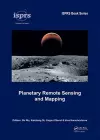
Planetary Remote Sensing and Mapping
4 contributors - Hardback
£185.00
Bo Wu is an Associate Professor with the Department of Land Surveying & Geo-Informatics of the Hong Kong Polytechnic University, mainly working on Photogrammetry and Planetary Mapping. He worked on NASA funded projects on Mars and lunar exploration missions when he was a researcher at the Ohio State University in the United States. At the Hong Kong Polytechnic University, he worked on the landing site mapping and selection for China’s Chang’E-3 lunar landing mission, and has been leading a team working on the landing site characterization and selection for the Chang’E-4 and Chang’E-5 missions and China’s first Mars exploration mission. He served as the Vice President of the Hong Kong Geographic Information System Association, the Co-Chair of the International Society for Photogrammetry and Remote Sensing (ISPRS) Working Group II/6: Geo-Visualization and Virtual Reality, and currently is serving as the Secretary of the ISPRS Inter-Commission Working Group III/IV: Planetary Remote Sensing and Mapping. He received a number of academic awards during his career, including the Talbert Abrams Award and John I. Davidson President’s Award from American Society for Photogrammetry and Remote Sensing (ASPRS), the R. Alekseev Award and Gold Medal from the 44th International Exhibition of Inventions of Geneva, and the Duane C. Brown Senior Award from the Ohio State University. He is currently the Associate Editor of the international journal “Photogrammetric Engineering & Remote Sensing” and an Editorial Board member of the “ISPRS Journal of Photogrammetry and Remote Sensing” and “The Photogrammetric Record”.
Kaichang Di is a professor with the Institute of Remote Sensing and Digital Earth (RADI), Chinese Academy of Sciences (CAS). He received his Ph.D. degree in photogrammetry and remote sensing from Wuhan Technical University of Surveying and Mapping (WTUSM) (now Wuhan University) in 1999. He participated in the Mars Exploration Rover mission and contributed to rover localization and mapping for mission operations, when he was a Research Scientist with the Department of Civil and Environmental Engineering and Geodetic Science, The Ohio State University (OSU). He is now director of the Planetary mapping and Remote Sensing Laboratory at RADI. He is involved in tele-operation of the Chang’E-3 rover using visual navigation and environment perception techniques, and has been leading a team to develop new vision-based techniques to support China’s future lander and rover missions. He was co-chair of International Society for Photogrammetry and Remote Sensing (ISPRS) Planetary Mapping and Databases Working Group from 2008 to 2016, and he has been chair of ISPRS Planetary Remote Sensing and Mapping Working Group since 2016. He received numerous academic awards during his career, including the first prize of Wang Zhizhuo Innovation Talent Award from WTUSM, the Duane C. Brown Senior Award from OSU, 1st place of John I. Davidson President's Award for practical papers and 1st place of ESRI Award for best scientific paper in GIS from American Society for Photogrammetry and Remote Sensing, NASA Group Achievement Award for Mars Exploration Rover mission team, Hundred Talent Program Award from CAS, and first prize of Surveying and Mapping Science and Technology Progress Award from China Society for Surveying, Mapping and Geoinformation.
Jürgen Oberst (Ph.D.: The University of Texas, 1989) is a professor and faculty member of the Technical University Berlin, Institute of Geodesy and Geoinformation Science, and head of the Planetary Geodesy Department of the DLR Institute of Planetary Research. He was/is involved in many past/ongoing planetary science missions specializing in the areas of planetary geodesy and geophysics. He is a Co-Investigator in the team of the HRSC (High Resolution Stereo Camera) on Mars Express and also a member of instrument and science teams of NASA’s Lunar Reconnaissance Orbiter and MESSENGER missions. He is also the Science Coordinator for the Laser Altimeter Experiments BELA and GALA on ESA’s Bepi Colombo and the JUICE missions, soon to be launched. Prof. Oberst was winner of a Megagrant awarded by the Ministry of Education and Science of the Russian Federation and consequently Leading Scientist of the Extraterrestrial Laboratory of MIIGAiK (Moscow State University for Geodesy and Cartography) from 2011 to 2015. He was/is PI of planetary science projects supported by the European Union, by ESA, the Helmholtz Association, and the German Science Foundation. Prof. Oberst is member of the IAU/IAG working group on Coordinates and Rotational Elements of the Planets and Satellites as well as Co-chair of the ISPRS Planetary Remote Sensing and Mapping Working Group.
Irina Karachevtseva (Ph.D. from Moscow State University of Geodesy and Cartography (MIIGAiK), 2005). She is head of MIIGAiK Extraterrestrial Laboratory (MExLab). She was involved in preparation of Russian mission to Phobos (Phobos-Grunt, 2011) and received the certificate of Helmholtz Association, Germany (2014) for the successful implementation of scientific research within the framework of the Helmholtz-Russia Joint Research Groups (HRJRG-205) focused on Phobos study. Irina Karachevtseva is an initiator and responsible editor of the collective monograph "Atlas of Phobos" (MIIGAiK, 2015), which includes more than 40 maps and the results of studies of this Martian satellite. A set of planetary maps for the Moon, Phobos, Mercury have been published recently under her leadership. One of her research branches is cartographic support of future Russian landing missions to the Moon: Luna-Glob (Luna-25, 27) and planning of future orbital mission Luna-Resource (Luna-26). Irina Karachevtseva is the co-chair of Planetary Remote Sensing and Mapping Working Group of the International Society for Photogrammetry and Remote Sensing (ISPRS) and co-chair of the Planetary Cartography Commission of the International Cartographic Association (ICA).